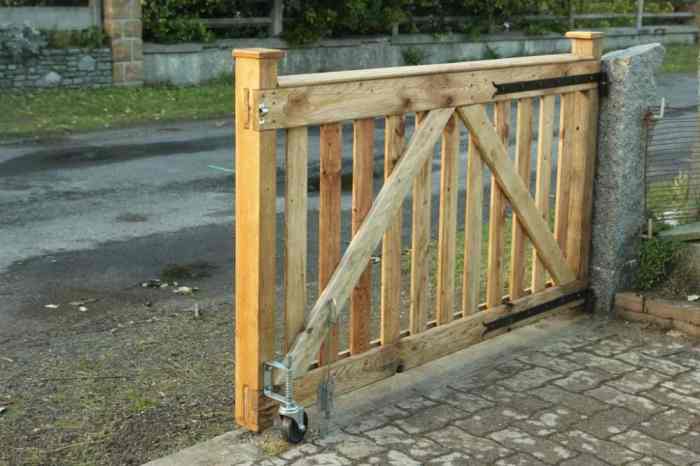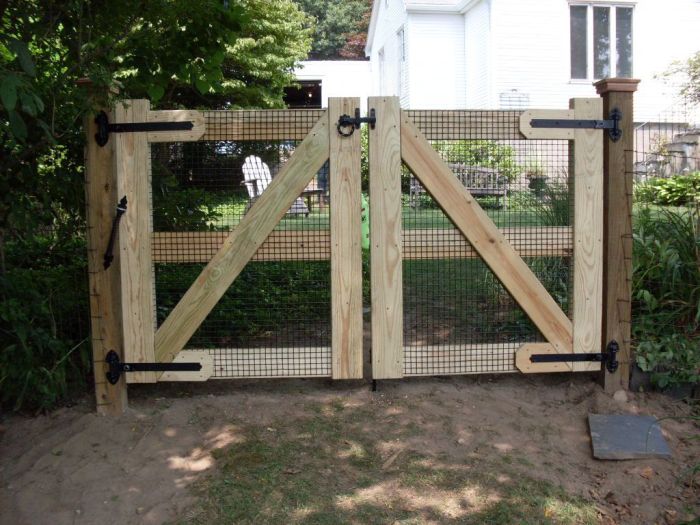DIY gate ideas offer a fantastic way to enhance your property’s curb appeal and security while showcasing your creativity. Whether you’re seeking a simple, functional gate or a statement piece, building your own gate can be a rewarding project. With a bit of planning, the right materials, and some basic DIY skills, you can create a custom gate that perfectly complements your home’s style and functionality.
Table of Contents
This comprehensive guide will walk you through the entire process, from planning and design to construction and installation. We’ll explore various gate styles, materials, and hardware options, ensuring you have all the information needed to embark on your DIY gate journey.
Planning Your DIY Gate Project: Diy Gate Ideas

Before you start building, it’s crucial to plan your gate project carefully. This involves considering various factors like size, style, and materials, which will influence the final outcome and functionality of your gate. Proper planning ensures that your project runs smoothly and that you have all the necessary materials and tools before you begin.
Determining Gate Size and Style, Diy gate ideas
The size of your gate will depend on the opening it needs to cover. It’s important to measure the opening accurately, leaving some extra space for the gate to swing freely. You’ll also want to decide on the style of your gate, considering factors like your home’s architectural style, your personal preferences, and the overall design of your fence. There are various styles to choose from, including single gates, double gates, sliding gates, and pedestrian gates.
Choosing Materials
The material you choose for your gate will impact its durability, appearance, and cost. Some common materials for DIY gates include:
- Wood: Wood is a popular choice for gates, offering versatility in style and design. It can be stained or painted to match your home’s aesthetic. However, wood requires regular maintenance to prevent rotting and insect damage.
- Metal: Metal gates, such as those made from wrought iron or aluminum, are durable and low-maintenance. They offer a more modern look and can be customized with intricate designs. However, metal gates can be more expensive than wooden gates.
- Vinyl: Vinyl gates are a popular choice for their low maintenance and durability. They are resistant to weather damage and insects. However, they may not offer the same aesthetic appeal as wood or metal gates.
Essential Tools and Equipment
To build a DIY gate, you’ll need a few essential tools and equipment. These include:
- Measuring tape: Accurate measurements are crucial for a well-fitting gate.
- Level: A level ensures that your gate frame is perfectly straight and horizontal.
- Saw: A saw is needed for cutting wood or metal to size. The type of saw you need will depend on the material you’re using.
- Drill: A drill is used for drilling holes for hinges, latches, and other hardware.
- Screwdriver: A screwdriver is essential for assembling the gate frame and attaching hardware.
- Clamps: Clamps help to hold pieces of wood or metal together while you’re working.
- Safety gear: Safety glasses, gloves, and a dust mask are essential for protecting yourself from injuries and dust.
Measuring and Marking the Gate Frame
Once you’ve determined the size and style of your gate, you need to accurately measure and mark the gate frame. It’s essential to be precise with your measurements, as even a small error can result in a gate that doesn’t fit properly. Here are some tips for measuring and marking the gate frame:
- Measure twice, cut once: This adage is especially important when working with wood or metal. Double-check your measurements before making any cuts.
- Use a pencil or marker: Mark your measurements clearly on the wood or metal using a pencil or marker.
- Consider the thickness of the material: When measuring for the gate frame, make sure to account for the thickness of the material you’re using.
Adding Gate Panels

Once your gate frame is built, it’s time to add the panels. This step determines the look and functionality of your gate. You can choose from a variety of materials and styles to create a gate that fits your needs and aesthetic preferences.
Paneling Options
The choice of paneling material depends on your budget, desired look, and the environment.
- Wood Slats: A classic choice, wood slats offer a natural, rustic look. They can be stained or painted to match your existing fence. You can choose different slat widths and spacing for various visual effects.
- Metal Panels: Metal panels, such as aluminum or steel, are durable and weather-resistant. They come in various styles, including corrugated, picket, or solid sheets. Metal panels are often used for modern or contemporary gates.
- Latticework: Latticework provides a decorative, airy look. It is typically made from wood and can be stained or painted to match your gate frame. Latticework can be used for both privacy and aesthetic purposes.
Attaching Panels to the Frame
Once you’ve chosen your paneling material, you need to attach it to the gate frame securely. There are various methods for attaching panels:
- Screws: Screws are a strong and durable option for attaching panels. Use screws that are long enough to penetrate the panel and frame securely. Countersink the screw heads for a clean, flush look.
- Nails: Nails are a quick and easy option for attaching panels. Use galvanized nails to prevent rusting. Make sure the nails are long enough to secure the panel to the frame.
- Staples: Staples are a good option for attaching thin panels, such as latticework. Use a staple gun that is powerful enough to drive staples through the panel and frame.
Ensuring Secure and Aesthetically Pleasing Panels
- Pre-drill Holes: Pre-drilling holes before attaching panels helps prevent the wood from splitting, especially when using screws or nails. This is particularly important for hardwood panels.
- Consistent Spacing: Ensure consistent spacing between panels for a clean, professional look. Use a measuring tape and a pencil to mark the panel positions before attaching them.
- Finishing Touches: After attaching the panels, finish them with stain, paint, or sealant to protect them from the elements and enhance their appearance.
Safety Considerations
Building a gate can be a rewarding project, but it’s essential to prioritize safety throughout the process. Neglecting safety measures can lead to accidents and injuries, so it’s crucial to follow best practices and be mindful of potential hazards.
Identifying Potential Hazards
- Falling Objects: Working at heights while installing gate panels or hardware can lead to objects falling and causing injury.
- Power Tool Accidents: Using power tools like saws, drills, and sanders requires careful handling to avoid cuts, splinters, and other injuries.
- Heavy Lifting: Lifting heavy gate panels or materials can strain muscles and cause back injuries.
- Sharp Edges: Working with wood or metal can result in cuts from sharp edges or tools.
- Pinch Points: When installing hinges or latches, be cautious of pinch points where fingers can be trapped.
Securing the Gate
- Sturdy Posts: Ensure the gate posts are securely anchored in concrete or embedded deep into the ground to prevent the gate from becoming unstable or falling.
- Strong Hinges: Use heavy-duty hinges designed for the weight of the gate to prevent sagging or failure.
- Secure Latches: Install a reliable latch that securely locks the gate in place, preventing it from swinging open unintentionally.
- Proper Hardware: Use high-quality screws, bolts, and other hardware that are appropriate for the weight and size of the gate.
Preventing Accidents
- Wear Protective Gear: Always wear safety glasses, gloves, and work boots to protect against injuries from falling objects, sharp edges, and heavy lifting.
- Use Proper Lifting Techniques: Bend your knees and lift with your legs, not your back, when handling heavy objects.
- Use Power Tools Safely: Follow the manufacturer’s instructions for operating power tools and always wear safety goggles.
- Work in a Safe Environment: Ensure the work area is clear of obstacles and distractions, and use caution when working around stairs or other potential hazards.
- Get Help When Needed: Don’t hesitate to ask for help when lifting heavy objects or working at heights.
Building a DIY gate can be a rewarding experience, allowing you to create a unique and personalized entrance to your property. From planning and selecting materials to construction and installation, each step offers opportunities to express your creativity and enhance your home’s curb appeal. With the right tools, materials, and a little patience, you can successfully build a beautiful and functional gate that will stand the test of time. Remember to prioritize safety throughout the process and enjoy the satisfaction of creating something truly your own.
DIY gate ideas can be a fun and rewarding project. If you’re looking for a durable and long-lasting option, consider incorporating metal into your design. You might even want to build a DIY metal shed to house your tools and supplies. Once your shed is built, you can add a custom gate that complements the style of your shed and adds a touch of personality to your outdoor space.


